Landingpage Optimierung im Jahr 2025: Personalisieren Sie, um Besucher in Kunden zu verwandeln
Traditionelle Tipps zur Landing Page Optimierung (LPO) funktionieren nicht mehr. Warum? Weil Ihre Besucher Individuen mit einzigartigen Vorlieben, Verhaltensweisen und Problemen sind. Sehen Sie, wie sich die Landingpage Optimierung verändert.

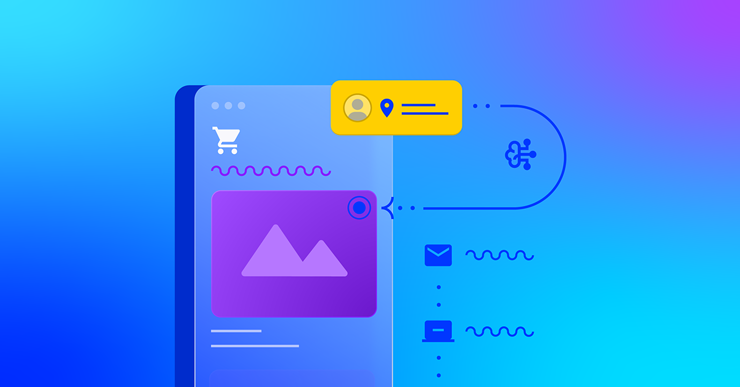
Sie möchten also eine Landing Page für die Leadgenerierung optimieren...
Früher reichten eine einprägsame Überschrift und eine auffällige CTA-Schaltfläche auf Ihrer Landing Page aus, damit es Leads regnete. Diese Zeiten sind jedoch so tot wie MySpace.
Denn die traditionellen Tipps zur Landing Page Optimierung (LPO) funktionieren nicht mehr. Ihre Besucher sind nicht mehr nur namenlose, gesichtslose Klicks. Sie sind Individuen mit einzigartigen Vorlieben, Verhaltensweisen und Problemen. Und sie erwarten, dass Sie das wissen.
Die Personalisierung macht Landing Pages von allgemeinen Werbetafeln zu dynamischen, umsatzsteigernden Maschinen. In diesem Blog erfahren Sie, wie sich die Optimierung von Landing Pages verändert und welche Beispiele es für die Optimierung von Landing Pages gibt.
LPO und Personalisierung: Ein deutlicher Wandel im Verbraucherverhalten
Die Landingpage Optimierung ist nicht tot. Sie hat sich weiterentwickelt.
Epsilon hat herausgefunden, dass 80% der Verbraucher bereit sind, ihr Portemonnaie zu öffnen, wenn eine Marke personalisierte Erlebnisse anbietet. Auch wenn es bei der Landing Page Optimierung immer noch darum geht, Besucher in Leads oder Kunden zu verwandeln. Aber Sie können einfach A/B-Tests für die Farben von Schaltflächen durchführen (obwohl das immer noch seine Berechtigung hat).
Personalisierung hebt die LPO auf die nächste Stufe. Sie ermöglicht es Ihrer Landing Page,:
- Vorhersagen, was jeder Besucher auf der Grundlage seines Verhaltens und seiner Daten möchte
- Inhalte bereitstellen, die auf die spezifischen Probleme des Besuchers eingehen
- Anpassung in Echtzeit auf der Grundlage von Besucherinteraktionen
Nehmen Sie dieses Beispiel für die Landingpage Optimierung:
Anbieter generieren mehr Umsatz, indem sie länderspezifische Preisoptionen anbieten.
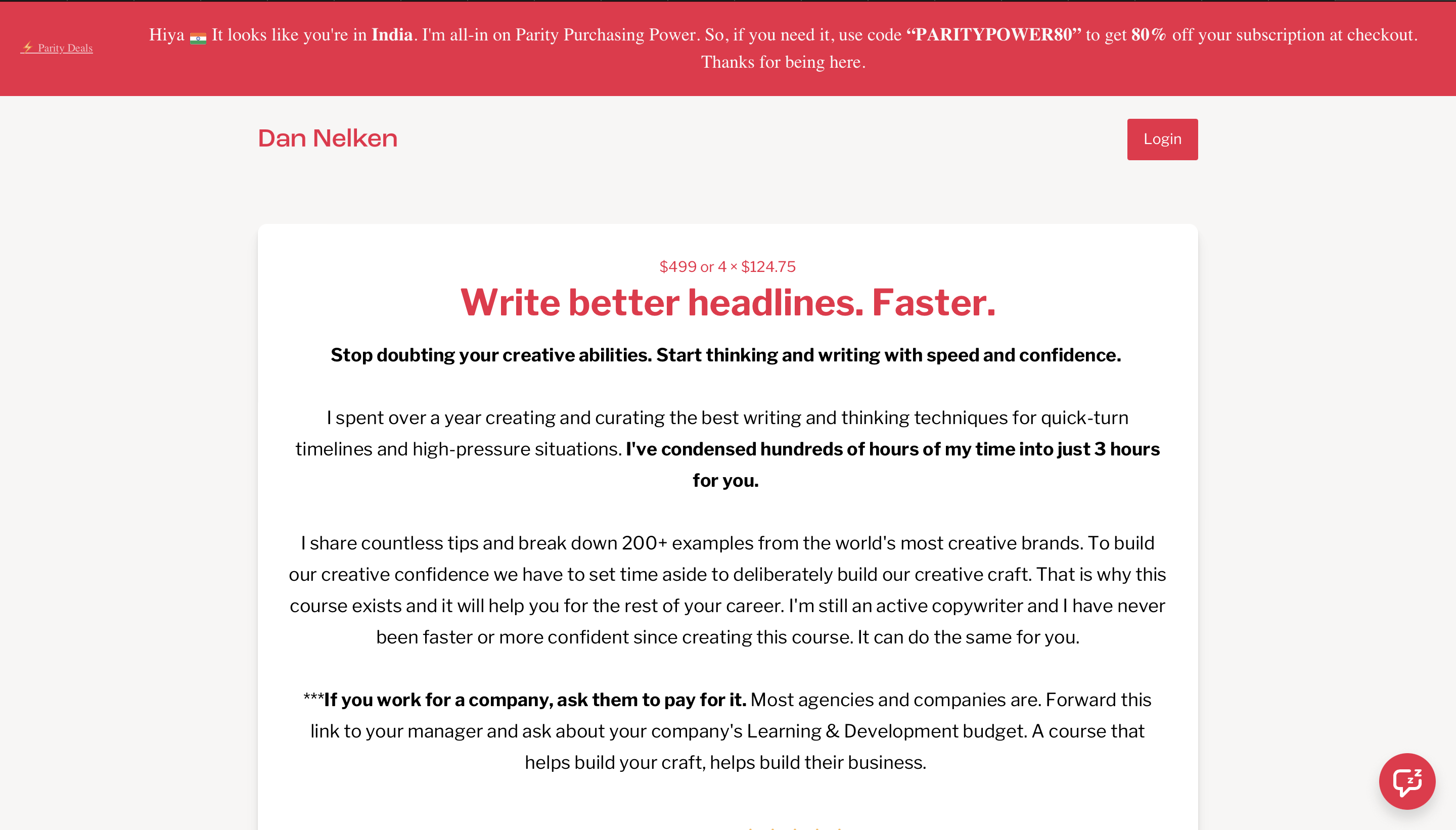
Bausteine für die personalisierte Landing Page Optimierung
Wie setzen Sie also Personalisierung ein, um optimierte Landing Pages zu erstellen? Schauen wir uns die wesentlichen Komponenten an:
Daten-Infrastruktur
Ihre Personalisierungsengine basiert auf Daten. Schaffen Sie eine solide Grundlage mit:
- First-Party-Datenerfassung: Nutzen Sie progressive Profilerstellung, Verhaltenstracking und direktes Feedback.
- Datenintegration: Kombinieren Sie CRM, Webanalyse, soziale Medien, Kaufhistorie und Supportdaten.
- Ziehen Sie eine Customer Data Platform (CDP) in Betracht, um umfassende Besucherprofile zu erstellen.
Content-Strategie
Personalisierung erfordert Vielfalt. Entwickeln Sie ein skalierbares Konzept für Inhalte:
- Dynamische Inhaltserstellung: Verwenden Sie Tools zur Erstellung von Variationen der Kernbotschaften, einschließlich personalisierter Beschreibungen und CTAs.
- Modulare Inhalte: Zerlegen Sie Inhalte in wiederverwendbare Teile, um sie einfach zu kombinieren und zu personalisieren.
KI und maschinelles Lernen
Nutzen Sie KI, um Daten und Inhalte zusammenzubringen:
- Prädiktive Analysen: Prognostizieren Sie das Nutzerverhalten, um relevante Inhalte bereitzustellen.
- Entscheidungsfindung in Echtzeit: Setzen Sie Systeme ein, die schnell Inhalte für jeden Besucher auswählen und aus Interaktionen lernen.
Optimieren Sie Ihren Ansatz kontinuierlich auf der Grundlage von Leistungsdaten und sich verändernden Nutzerbedürfnissen.
Tipps zur Landingpage Optimierung für das Jahr 2025
Hier sind fünf Tipps, die Sie bei der Optimierung von Landing Pages für die Leadgenerierung beachten sollten.
-
Dynamische Anpassung des Inhalts
Passen Sie Ihre Landing Page in Echtzeit an das Verhalten der einzelnen Besucher an.
- Passen Sie Seitenelemente auf der Grundlage von Benutzeraktionen an
- Heben Sie Wertangebote für preissensible Besucher hervor
- Präsentieren Sie Funktionen für Benutzer, die sich auf Funktionen konzentrieren
-
Personalisierte Videoinhalte
Vidyard berichtet , dass 88% der Verbraucher mehr Videoinhalte sehen möchten. Nutzen Sie Videoinhalte:
- Erstellen Sie personalisierte Video-Begrüßungen anhand von Besucherdaten
- Nutzen Sie dynamische Einblendungen für personalisierte Angebote
- A/B-Testing von Videostilen und -längen für verschiedene Segmentierungen
-
Suchoptimierte Landing Pages
Dieser Ansatz verbessert sowohl die Suchrankings als auch die Relevanz der Besucher:
- Passen Sie den Inhalt an die Suchabsicht an
- Erstellen Sie personalisierte Meta-Beschreibungen
- Verwenden Sie Schema-Markup für ein besseres Verständnis durch Suchmaschinen
-
Konversations-Chatbots
Laut Drift generieren 55% der Unternehmen, die Chatbots einsetzen, effektiv mehr hochwertige Leads.
- Verwenden Sie KI-gesteuerte Chatbots für die Besucherführung
- Nutzen Sie Natural Language Processing für bessere Interaktionen
- Personalisieren Sie Chatbot-Antworten auf der Grundlage von Benutzerdaten, um eine menschliche Note hinzuzufügen.
-
Fortgeschrittenes Experimentieren
Setzen Sie auf eine nuanciertere, zielgruppenspezifische Optimierung.
- Führen Sie multivariate Tests für alle Seitenelemente durch.
- Analysieren Sie die Ergebnisse auf einer granularen Ebene für verschiedene Segmente
Test + Learn: Experimentation
Beispiele für die Optimierung von Landing Pages
Bevor Sie mit der Optimierung beginnen, sollten Sie Ihre Site-Besucher kennenlernen.
Website-Besucher lassen sich in der Regel in drei Kategorien einteilen:
- Bereit zum Kauf: Diese Besucher sind bereit für eine Conversion und brauchen einen klaren, reibungslosen Weg zum Kauf.
- Werden nie kaufen: Sie sind zwar nicht Ihr Targeting, aber ihr Verhalten kann Ihnen wertvolle Hinweise darauf geben, was nicht funktioniert.
- Interessiert, muss aber überzeugt werden: Diese Gruppe ist die größte Chance für Ihre Optimierungsbemühungen.
Hier sind einige Beispiele dafür, wie Sie dies tun können.
Beispiel 1
Wenn Sie ein Newcomer sind (wie Harry's), der gegen einen etablierten Konkurrenten antritt, der 50% des Marktes besitzt (Gillette), können Sie eine überzeugende CTA für Ihre Produktseite ausprobieren.
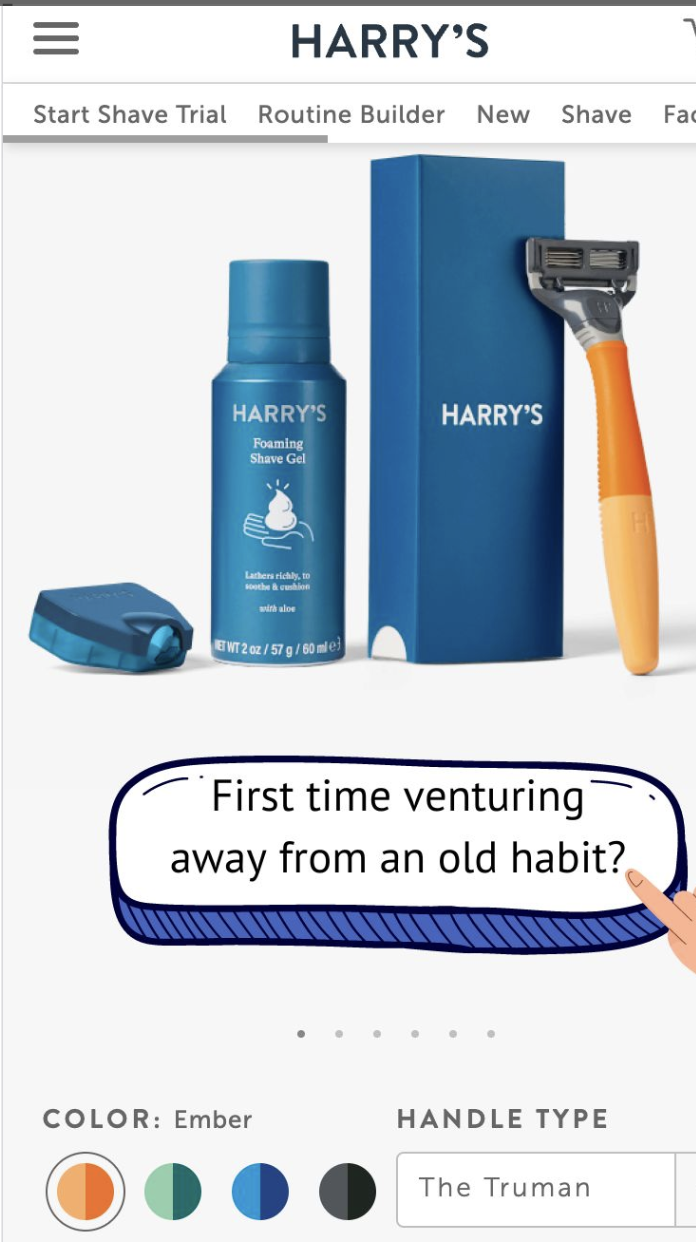
Beispiel 2
Effektives Marketing bevorzugt oft Klarheit gegenüber Kreativität. Betrachten Sie diese Überschrift:
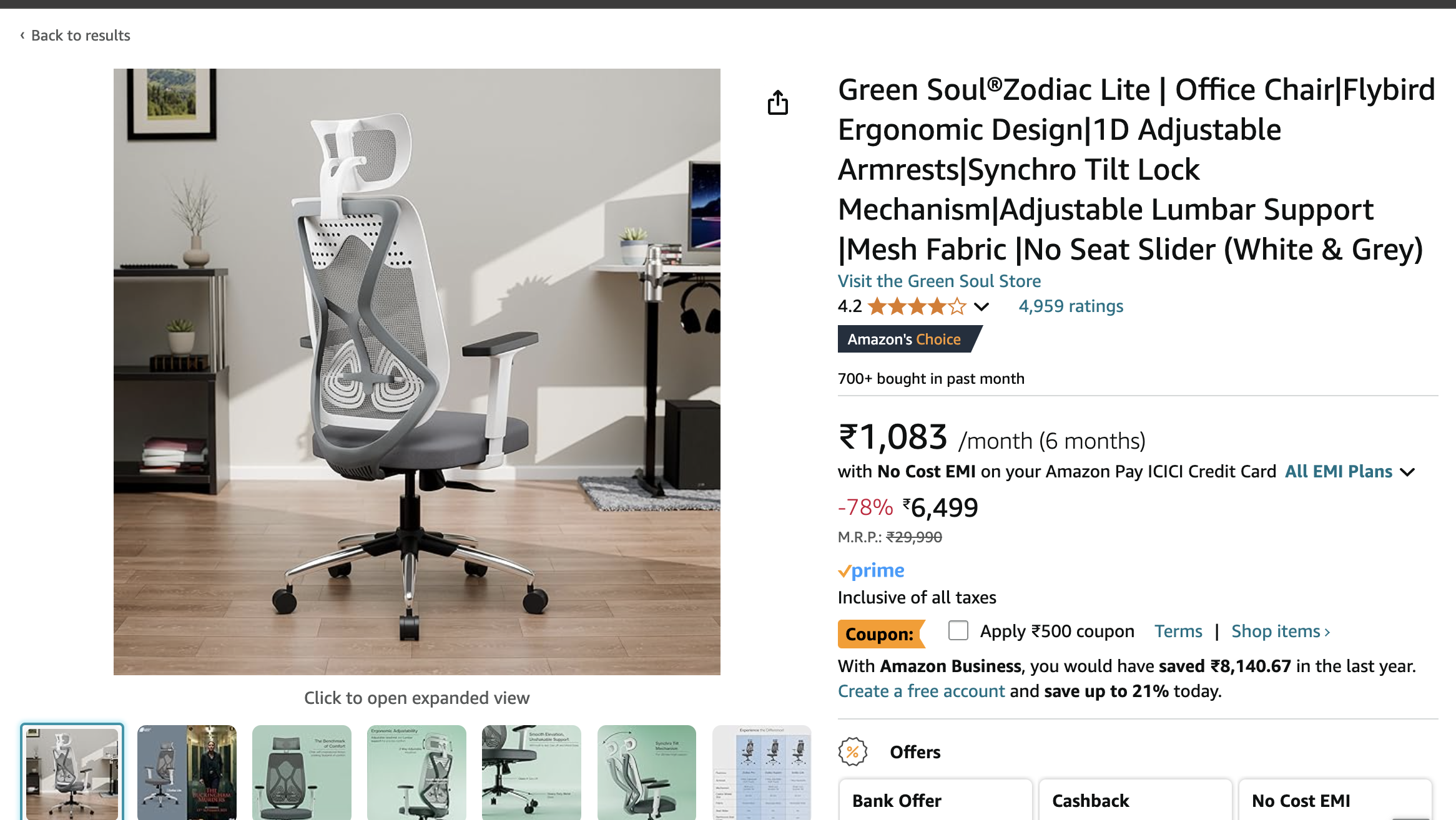
- Eine große Schriftgröße sorgt für Lesbarkeit.
- Die Schlüsselbotschaft befindet sich in der Überschrift - dem meistgelesenen Element.
Sie wird vielleicht keine Preise gewinnen, aber sie wird wahrscheinlich zu mehr Verkäufen führen.
Beispiel 3
Nur sehr wenige Besucher betreten Ihre Site mit der Absicht, etwas zu kaufen.
Die meisten kommen, um sich schnell und aus der Ferne zu informieren.
Wenn es dem Vermarkter nicht gelingt, diese "schnelle" und "distanzierte" Einstellung zu ändern, gibt es keine Hoffnung auf einen Verkauf.
Auf der Matratzen-Seite von Casper finden Sie eine Vergleichstabelle, in der die Matratze, die Sie sich ansehen, mit Caspers höherwertigem Modell verglichen wird.
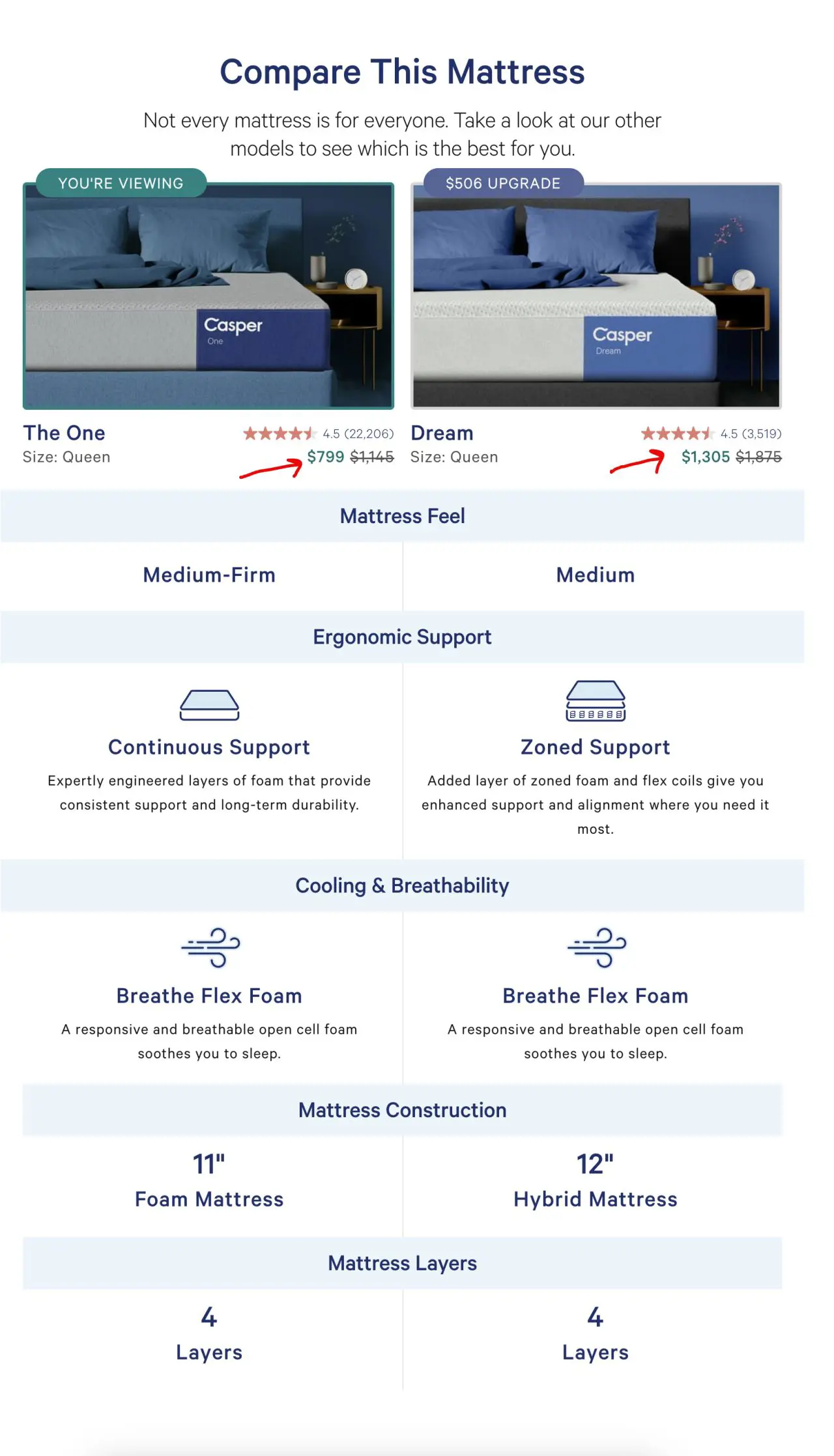
Tools für die Landingpage Optimierung
Um die oben genannten Tipps umzusetzen, sollten Sie die folgenden Tools in Betracht ziehen:
- Customer Data Platforms (CDPs): CDPs vereinheitlichen Kundendaten aus verschiedenen Quellen. Zu den besten Optionen gehören Segment und BlueConic.
- Plattformen zur Personalisierung: Diese Plattformen schaffen personalisierte Erlebnisse über digitale Eigenschaften hinweg. Ziehen Sie Optimizely oder Dynamic Yield in Betracht.
- Analyse- und Zurechnungstools: Messen Sie die Auswirkungen Ihrer Personalisierungsbemühungen mit Tools wie Google Analytics 4 oder Mixpanel. Achten Sie auf prädiktive Analysen und Multi-Touch-Attributionsfunktionen.
- Content Management Systeme (CMS): Moderne CMS-Plattformen enthalten häufig eine integrierte Personalisierung. Zu den Optionen gehören Optimizely CMS und Contentful (mit Erweiterungen).
- Heatmapping und andere Optimierungstools: Für Heatmapping empfehlen wir Hotjar oder Crazy Egg. Für die Optimierung der Seitengeschwindigkeit empfehlen wir GTmetrix oder PageSpeed Insights.
Landingpage Optimierung: Was kommt als Nächstes?
Bald wird KI in der Lage sein, Hunderte von Datenpunkten in Echtzeit zu analysieren, um wirklich einzigartige Erlebnisse für jeden Besucher zu schaffen. Sie werden nicht nur vorhersagen, was ein Nutzer als nächstes tun könnte, sondern ganze Customer Journeys prognostizieren, so dass Sie schon bei der ersten Interaktion den Lifetime Value optimieren können.
Stellen Sie sich Landing Pages vor, die die Emotionen Ihrer Besucher lesen und auf sie reagieren können. Frustrierter Benutzer? Ihre Seite könnte automatisch ihr Layout vereinfachen. Begeisterter Interessent? Sie könnte den Enthusiasmus in ihren Botschaften steigern.
Damit dies möglich ist, müssen Sie eine datengesteuerte Kultur fördern und klare Richtlinien für den ethischen Einsatz von KI im Marketing entwickeln. Außerdem sollten Sie flexible, integrationsbereite Tech-Stacks entwickeln.
Eine gut optimierte Landing Page steht nicht nur im Einklang mit Ihrer Marketingstrategie, sondern sorgt auch dafür, dass Ihre Besucher schneller konvertieren, als Sie "CTA" sagen können.
Doch bevor Sie (im Gegensatz zu Ihren bald optimierten Landing Page-Besuchern) abspringen, lassen Sie uns das Thema abschließen.
Bei der Optimierung Ihrer Landing Page geht es nicht nur darum, sie hübsch zu machen. Es geht darum:
- Ihr Wertversprechen auf den Punkt bringen
- Mehrwert schaffen, anstatt die Preise zu senken
- Testen, Wiederholen, Optimieren
- Ihre Preisgestaltung transparent zu gestalten
- Ihren Kunden zu helfen, die beste Wahl zu treffen
- Vermeiden Sie manipulative Taktiken
- Regelmäßige Analyse des Nutzerverhaltens
Die Arbeit mit einer Optimierungsplattform wie Optimizely ermöglicht es Ihrem Team, datengesteuert, nutzerorientiert und ergebnisorientiert zu arbeiten. Das fördert die Kreativität, die Effizienz und vor allem die Conversions.
![]()

